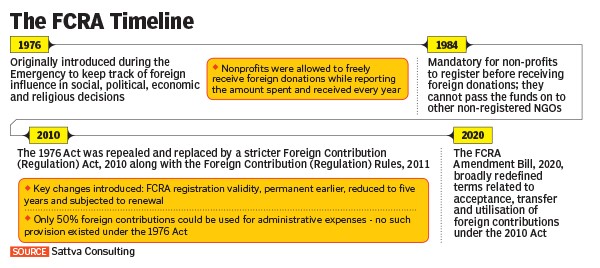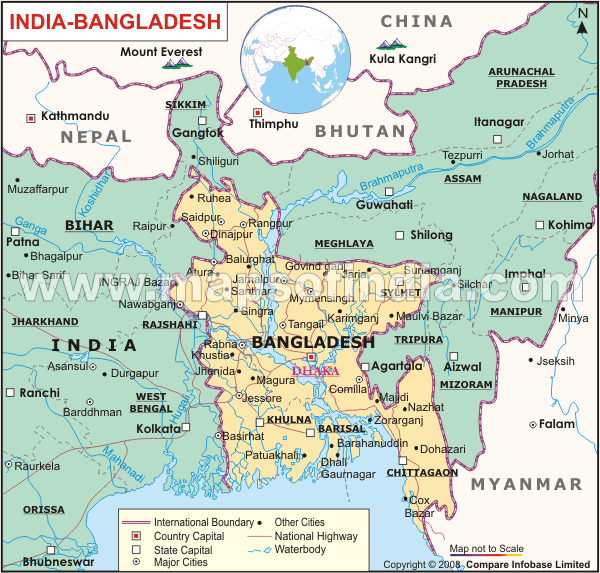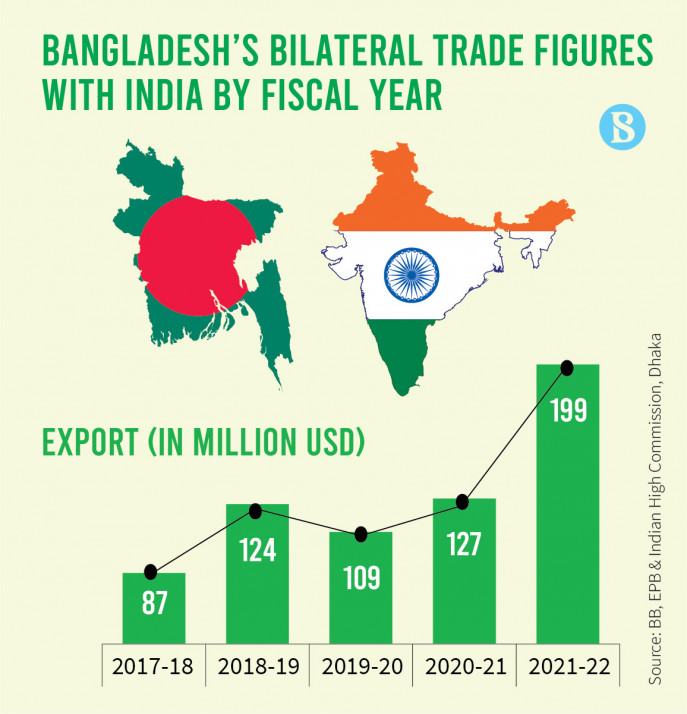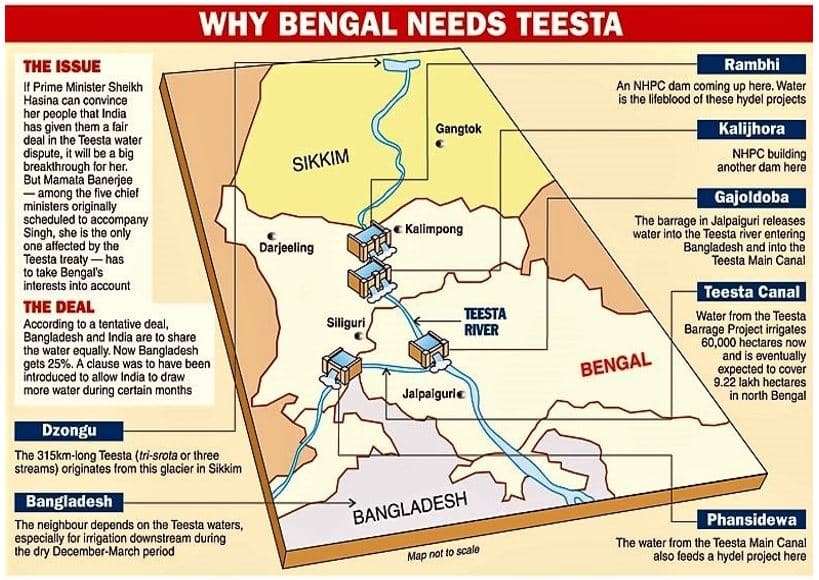CONTENTS
- Curbs on Financing of Civil Society Bodies
- India- Bangladesh Ties
Curbs on Financing of Civil Society Bodies
Context:
In less than a year after suspending the Foreign Contribution (Regulation) Act (FCRA) license of the Centre for Policy Research (CPR), the Government of India has now revoked its FCRA license. The rationale behind this action—associating CPR’s publications with current affairs programming, which is prohibited for an entity using FCRA funds—seems absurd.
Relevance:
GS2-
- Government Policies and Interventions
- Non-Governmental Organisations (NGOs)
Mains Question:
“Curbs on financing of civil society bodies denote eroding civil liberties.” Analyse in the context of the recent suspension of the Foreign Contribution (Regulation) Act (FCRA) license of the Centre for Policy Research (CPR). (10 Marks, 150 Words).
Centre for Policy Research (CPR):
- The Government of India acknowledges CPR as a non-profit society, and contributions made to the Centre are eligible for tax exemptions, as stated on its website.
- CPR is a recipient of grants from the Indian Council for Social Science Research (ICSSR) and is recognized as an institution by the Department of Science and Technology.
- CPR obtains grants from diverse domestic and international sources, encompassing foundations, corporate philanthropy, government entities, and multilateral agencies.
- As a prominent think tank with a history spanning more than half a century, CPR has served as a model of public-spirited scholarship contributing to a governance and policy-making ecosystem.
- This environment involves multiple stakeholders with often divergent interests that necessitate consensus-building through informed debates—an essential characteristic of a democracy.
Foreign Contribution (Regulation) Act (FCRA):
- The Foreign Contribution (Regulation) Act (FCRA) was enacted during the Emergency in 1976, prompted by concerns that foreign powers were interfering in India’s affairs by channeling funds through independent organizations.
- The primary objective of the law was to regulate foreign donations to individuals and associations.
- In 2010, an amended version of FCRA was introduced to “consolidate the law” regarding the utilization of foreign funds and “to prohibit” their use for activities deemed detrimental to national interest.
- Subsequently, in 2020, further amendments were made, granting the government increased control and scrutiny over the receipt and utilization of foreign funds by NGOs.
- FCRA mandates that any individual or NGO seeking to receive foreign donations must:
- Be registered under the Act.
- Open a bank account for the receipt of foreign funds in the State Bank of India, Delhi.
- Utilize those funds solely for the purpose for which they have been received, following the stipulations in the Act.

- The Act expressly prohibits the receipt of foreign funds by candidates for elections, journalists or entities involved in newspaper and media broadcast, judges, government servants, members of the legislature, political parties, or their office-bearers, as well as organizations of a political nature.
- Upon the enactment of the latest amendments in 2020, the International Commission of Jurists condemned them as “incompatible with international law” and cautioned that they would “impose… extraordinary obstacles on the capacity of… civil society actors to carry out their important work.”
- It seems the government has been actively validating the concerns raised by the ICJ. Even before the dust could settle on the FCRA cancellation of CPR, World Vision India, an organization focused on children, has also faced FCRA cancellation.
Analysing the Government’s Recent Move:
- Opting to essentially shut down such an institution by undermining its financial stability sends a message that India may no longer be receptive to the free flow of knowledge and ideas.
- This move aligns with a recurring pattern wherein the state employs the FCRA as a tool to stifle entities whose work it disapproves of, typically those focused on environmental issues, civil liberties, and human rights.
- The use of the FCRA to target civil society for political or ideological reasons appears to be ingrained in its history.
- The legislation originated during the Emergency, enacted by a regime concerned about foreign governments interfering in India’s internal affairs by channeling funds through NGOs. Since then, it has undergone amendments by successive governments, with the provisions becoming increasingly stringent.
Democracy and Civil Liberties:
- On one hand, India aspires to be recognized as a ‘Vishwaguru,’ and it proudly claims the title of the ‘Mother of Democracy’ as the host of the G-20.
- The government displays hypersensitivity to international rankings while simultaneously refusing to acknowledge the interconnectedness of perception and reality.
- When the U.S.-based non-profit, Freedom House, downgraded India to an “electoral autocracy” in its Democracy Index, it cited the erosion of civil liberties as one of the reasons.
Conclusion:
The act of cutting off the finances of civil society organizations on unsubstantial grounds serves as a clear instance of the erosion of civil liberties, likely to intensify the narrative of democratic regression. It becomes futile to complain about bias or invoke “conspiracies” to tarnish India’s image when these actions contribute to India’s decline in global indices measuring freedom and democracy.
India- Bangladesh Ties
Context:
Prime Minister Sheikh Hasina secured a historic fourth consecutive term in Bangladesh earlier this month when her party, the Awami League, won two-thirds of the seats in the national elections held on January 7. Prime Minister Narendra Modi was among the first global leaders to extend his congratulations to Ms. Hasina, underscoring the strong bilateral relationship between India and Bangladesh.
Relevance:
GS-2-
- India and its Neighbourhood
- Bilateral Groupings & Agreements
Mains Question:
How have the economic, social and political ties of India and Bangladesh evolved over the years? What are the major points of contention between the neighbouring countries and what can be done to ensure a mutually beneficial and peaceful cooperation? (15 Marks, 250 Words).
Historical Evolution of India- Bangladesh Ties:
- The roots of India’s ties with Bangladesh can be traced back to the 1971 Bangladesh Liberation War, where India played a crucial role by providing essential military and material assistance for Bangladesh’s struggle for independence from Pakistan.
- However, relations turned strained in the subsequent years under military regimes, giving rise to anti-India sentiments in the mid-1970s. Issues such as boundary disputes, insurgency, and water-sharing conflicts contributed to the instability in the relationship.
- This situation persisted for several decades until Sheikh Hasina assumed power in 1996, ushering in a new era in bilateral relations.
- Her tenure saw the signing of a significant treaty on the sharing of Ganga waters, marking a turning point.
- Since then, India and Bangladesh have forged cooperation across various sectors, including trade, energy, infrastructure, connectivity, and defense.

Economic Ties Between India and Bangladesh:
- Bilateral trade between India and Bangladesh has experienced consistent growth over the past decade. Bangladesh has become India’s largest trade partner in South Asia, witnessing an increase in bilateral trade from $10.8 billion in 2020-21 to $18 billion in 2021-2022.
- However, there was a slight decline in 2022-23 due to the impact of the pandemic and the Russia-Ukraine war. India, in turn, stands as the second-largest trade partner for Bangladesh, with exports totaling $2 billion to Indian markets.

- In 2022, both countries successfully concluded a joint feasibility study on a Comprehensive Economic Partnership Agreement (CEPA).
- Typically aimed at reducing or eliminating customs duties on traded goods and streamlining trade regulations, the CEPA is expected to create broader social and economic prospects.
- The significance of the CEPA is heightened as Bangladesh is poised to lose its Least Developed Country (LDC) status after 2026, leading to the end of its duty-free and quota-free market access in India.
- In light of this, Dhaka is eager to finalize a Free Trade Agreement (FTA) with New Delhi and also explore the possibility of joining the China-backed Regional Comprehensive Economic Partnership (RCEP). This dual approach raises certain concerns for India.
Infrastructure Partnership and Development:
- India, recognized as a “major development partner” of Bangladesh, is actively supporting numerous infrastructure and connectivity initiatives. Since 2010, India has provided Lines of Credits amounting to over $7 billion.
- In a historic move, Prime Minister Modi and Sheikh Hasina inaugurated the Akhaura–Agartala rail link last year, connecting Bangladesh with the northeastern states through Tripura.
- This link has granted India access to Chattogram and Mongla ports in Bangladesh, facilitating the movement of cargo and is anticipated to stimulate small-scale industries while fostering the development of Assam and Tripura.
- In the energy sector, Bangladesh currently imports approximately 2,000 megawatts of electricity from India.
- The BIMSTEC Master Plan for Transport Connectivity emphasizes the integration of major transport projects in India, Bangladesh, Myanmar, and Thailand, creating an extensive shipping network.
- India’s strategic focus will likely be on the Matarbari Port, situated around 100 km from Tripura, which Bangladesh is in the process of constructing.
- This port is set to establish a crucial industrial corridor connecting Dhaka and the surrounding region.
Points of Tension Between India and Bangladesh:
- The imminent Teesta dispute is poised to become a focal point on the agenda of the Hasina-led government. This matter revolves around the equitable distribution of Teesta’s waters, with Bangladesh advocating for a fair share.

- Another contentious issue is the Rohingya matter. The Hasina administration aims for the peaceful repatriation of Rohingyas to Myanmar, but discussions with the military junta have not yielded success thus far. Bangladesh seeks India’s cooperation to exert influence on Myanmar, but the Modi government, with ties to the junta, asserts its intention to deport Rohingyas from its mainland.
- Additional threats to internal security include cross-border terrorism and infiltration. The emergence of majoritarian forces adds complexity to the landscape, with increased violence against Muslims in India over the past few years.
- Prime Minister Hasina has been at the forefront, condemning these attacks and expressing dissatisfaction with comments by Indian leaders regarding “illegal” immigrants.
Global Ties:
- The United States has been vocal in its criticism of the Awami League government, exerting pressure on Sheikh Hasina over concerns of “democratic backsliding.”
- In 2021, the Biden administration imposed sanctions on a Bangladeshi anti-crime and anti-terrorism task force, citing human rights violations, and heightened tensions by announcing a policy to restrict visas for Bangladeshis believed to be undermining the electoral process.
- Adding to India’s concerns is the deepening relationship between Bangladesh and China, characterized by significant Chinese investments in infrastructure in recent years.
- According to the Chinese Ambassador to Bangladesh, China has constructed 12 highways, 21 bridges, and 27 power and energy projects in Bangladesh. Despite this, Prime Minister Hasina has emphasized that her government is “very much careful” about its partnership with China.
Conclusion:
To address cross-border challenges, joint task forces with shared intelligence are recommended. Smart border management solutions, incorporating AI and data analytics, can improve efficiency and security. Additionally, the establishment of a digital connectivity corridor is proposed to promote high-speed internet, digital services, and e-commerce, fostering trade and technological collaboration.





